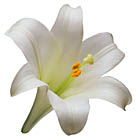Easter Lilies
An Ageless Holiday Tradition

Every holiday has its own cherished traditions that are lovingly passed down from generation to generation. At Easter, these joyous traditions often include egg decorating, gift baskets, chocolate bunnies, local church services, family gatherings, parades, and, of course, the Easter Lily. For many, its beautiful trumpet-shaped blossoms symbolize purity, hope, and life -- the spiritual essence of Easter -- and all the promises of Spring.
The Meaning of Easter Lilies
History, mythology, and art are filled with stories and images that speak of the beauty and majesty of the elegant white flowers. One of the most famous Biblical references is in the Sermon on the Mount, when Christ said, "Consider the lilies of the field, how they grow: they toil not, neither do they spin; and yet Solomon in all his glory was not arrayed like one of these."
Through the ages, allegorical tales have linked lilies to the sacrament of motherhood. Ancient fables tell us the lily sprang from the milk of Hera, the mythological Queen of Heaven. Roman mythology credits lilies to Juno, the queen of the gods. The story goes that while Juno was nursing her son Hercules, excess milk fell from the sky. Although part of it remained above the earth (thus creating the Milky Way), the remainder fell to the earth, creating lilies.
Often called the "white-robed apostles of hope," lilies are said to have been found growing in the Garden of Gethsemane after Christ's agony. Tradition has it that the beautiful white blooms sprung up where drops of Christ's sweat fell to the ground in his final hours of sorrow and deep distress. At Easter time, Churches bank their altars and surround their crosses with masses of Easter Lilies, to commemorate the resurrection of Jesus Christ and hope of life everlasting.
The pure white lily has long been associated with the Virgin Mary, too. In early paintings, the Angel Gabriel is pictured extending a branch of pure white lilies to the Virgin Mary, announcing that she is to be the mother of the Christ Child. In other paintings, saints are pictured bringing vases full of white lilies to Mary and the infant Jesus.
In yet another expression of womanhood, tradition has it that when Eve left the Garden of Eden she shed real tears of repentance, and from those remorseful tears sprung up lilies. The spiritual principle held here is that true repentance is the beginning of beauty.
A mark of purity and grace throughout the ages, the regal white lily is a fitting symbol of the greater meaning of Easter. Gracing millions of homes and churches, the flowers embody joy, hope and life. Whether given as a gift or enjoyed in your own home, the Easter Lily serves as a beautiful reminder that Easter is a time for rejoicing and celebrating.
One of America's Favorite Blooming Plants
We can thank Louis Houghton, a World War I soldier, for the popularity of the Bermuda lily --better known as the Easter Lily -- in this country. In 1919 he brought a suitcase full of hybrid lily bulbs to the southern coast of Oregon and gave them to family and friends to plant.
The climate there was ideal for growing this lily, a native of the Ryukyu Islands of Japan, and by 1945, over one thousand west coast growers were producing bulbs for the commercial market. Despite a sales window of only approximately two weeks each year, Easter Lilies are the fourth largest potted plant crop in the U.S., ranking among poinsettias, mums, and azaleas as America's favorite blooming plants.
Shop for Easter Flowers online.
Selecting the Perfect Easter Lily
Whether you plan to give plants as gifts or use them to decorate your own home, the following tips will help make your Easter Lilies keep on giving.
Two of the greatest charms of the Easter Lily are form and fragrance, so look for high quality plants that are aesthetically pleasing from all angles. Select medium to compact plants that are well balanced and proportional in size (not too tall or short).
For the longest possible period of enjoyment in your home, look for plants with flowers in various stages of bloom. For example, the best selection would be a plant with just one or two open or partly open blooms, and three or more unopened buds of different sizes. The ripe puffy buds will open up within a few days, while the tighter ones will bloom over the next several days.
As the flowers mature, remove the yellow anthers before the pollen starts to shed. This gives longer flower life and prevents the pollen from staining the white flowers. When a mature flower starts to wither after its prime, cut it off to make the plant more attractive while you still enjoy the fresher, newly-opened blooms.
When selecting plants, be sure to also cheek the foliage. An abundance of dark, rich green leaves is not only attractive, but a vital sign of good plant health. The foliage should appear dense and plentiful, all the way down to the soil line, a good indicator of an active, healthy root system.
Easter Lilies and Pets
According to the National Animal Poison Control Center (NAPCC), certain types of lilies can cause renal failure in cats that have ingested a portion of the lily. So, while Easter Lilies don't pose a threat to humans or other pets, Phillip's 1-800-FLORALS suggests they be kept out of reach of feline friends. For additional information, contact your veterinarian or visit the Animal Poison Control Center at ASPCA.
Caring For Easter Lilies
In the home, Easter Lilies prefer moderately cool temperatures. Ideal daytime temperatures are 60 to 65 degrees F., with slightly cooler temperatures at night. Avoid placing plants near drafts, and avoid exposure to excess heat or dry air from appliances, fireplaces, or heating ducts. The lily will thrive near a window in bright, indirect natural daylight, but avoid glaring, direct sunlight.
Easter Lilies prefer moderately moist, well-drained soil. Water the plant thoroughly when the soil surface feels dry to the touch, but avoid over-watering. If the pot is wrapped in decorative foil, be careful not to let the plant sit in trapped, standing water. For best results, remove the plant from decorative pots or covers, take it over the sink and water thoroughly until water seeps out of the pot's drain holes to completely saturate the soil. Allow the plant to air for a few minutes and discard the excess water before replacing it back into its decorative pot cover.
Planting Easter Lilies Outside
It is very difficult to force Easter lilies into bloom a second time indoors. An alternative is to plant them outdoors in Spring, where they may bloom again in summer or Fall. The plants will need a site with bright light but some shelter from extreme heat and wind.
Plant the Easter Lily bulbs 3 inches below ground level, and mound up an additional 3 inches of topsoil over the bulb. Plant bulbs at least 12 to 18 inches apart in a hole sufficiently deep so that the bulbs can be placed in it with the roots spread out and down, as they naturally grow. Spread the roots and work prepared soil in around the bulbs and the roots, leaving no air pockets. Water immediately and thoroughly after planting.
As the original plants begin to die back, cut the stems down to the soil surface. New growth will soon emerge. The Easter Lilies, which were forced to bloom under controlled greenhouse conditions in March, bloom naturally in the summer. So, you may be rewarded with a second bloom later in the summer or possibly even the following summer (depending on temperatures and conditions in your area).
Another planting tip to consider is that lilies like their roots in shade and their heads in the sun. Use mulching to help conserve moisture. Or, plant a "living mulch" of shallow-rooted, complementary annuals or perennials. Stately Easter Lilies rising above lacy violas or primulas is not only aesthetically pleasing, but also good gardening.
https://pss.uvm.edu/ppp/articles
https://www.aboutflowers.com
https://aggie-horticulture.tamu.edu/plantanswers/publications
https://www.ag.usask.ca/cofa/departments/hort/hortinfo/plants
